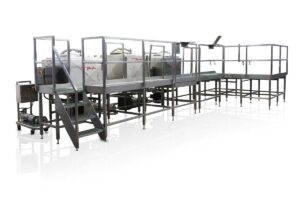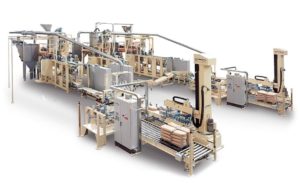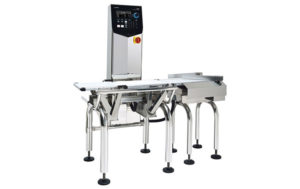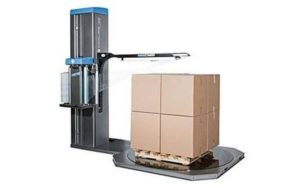Dry products, ranging in consistency from fine talcum powder to large chicken parts, may be filled by either volume or weight. Some products, such as hardware parts or pharmaceutical tablets, may also filled by piece count. All have advantages and drawbacks and this month I want to talk about filling by weight. More specifically, I want to talk about using combining scales.
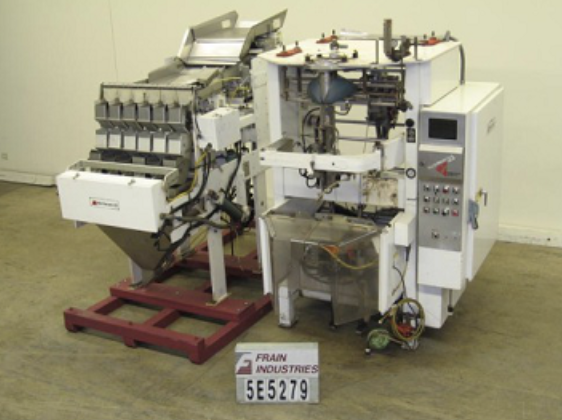 At its simplest, filling by weight dispenses product out of a hopper and into a container on a scale. When the target weight is reached, filling stops. This can be further refined with a bulk and dribble system. The bulk of the fill, 95-98%, is made at high speed. The balance of the fill is dribbled into the container at a slower speed. Filling by weight, especially of non-homogenous products like chicken parts, is going to be inaccurate. One of the difficulties is control of the flow and cutting it off precisely. Just as the correct weight is achieved, another chicken wing falls in.
At its simplest, filling by weight dispenses product out of a hopper and into a container on a scale. When the target weight is reached, filling stops. This can be further refined with a bulk and dribble system. The bulk of the fill, 95-98%, is made at high speed. The balance of the fill is dribbled into the container at a slower speed. Filling by weight, especially of non-homogenous products like chicken parts, is going to be inaccurate. One of the difficulties is control of the flow and cutting it off precisely. Just as the correct weight is achieved, another chicken wing falls in.
Combining scales eliminate much of this variability by spreading each fill across multiple individual scales. The basic principle is that an underweight fill will balance out an overweight fill. Combining scales can be arranged in a linear format such as this machine by Triangle
An alternative arrangement is this horizontal combing scale by Yamato Lock. This arrangement is simpler but has some drawbacks:
The main issue is size. A 12 or 16 bucket filler would be prohibitively wide. Since the filling buckets are not equi-distant from the container, products from the end buckets will take longer to reach the container than those in the middle. Speed and precision of a combining scale is a function of the number of weigh buckets. More buckets give more speed and precision. Many combining scales arrange the weighing buckets in a circle with discharge of each weighing bucket into a central funnel then into the container.

Combing scales look complicated but the basic principle is quite simple. A portion of the total fill weight is dispensed into each bucket. Each bucket is mounted on a scale and stops the flow when the preset weight is achieved. There will be variation in each bucket with some above and some below the fractional target weight. When the proper combination of buckets is made, the overweight and underweight buckets cancel each other and the total weight dispensed is close to the target weight.
For illustration, assume a 12 head scale. Product is added to the bulk supply in the center of the filler. A series of troughs, vibrates product into the bucket. Each trough is individually driven so that it can be turned off when the bucket scale indicates the proper weight. Each bucket is set for 3 ounces and filled as closely as possible to that weight. Actual weights are captured in the central control. When the container or bag is in place and ready for filling, the controller selects the four buckets that most closely provide a total of 12 ounces. That might be 2 buckets of 2.9 ounces, one of 3 ounces and one of 3.2 ounces.
These 4 buckets open and 12 ounces goes into the container. Once they have emptied, their trough reloads them with another 3 ounces, approximately, of product.
Higher speed combining scales may use more buckets wither primary weighing buckets and secondary staging buckets.
Secondary staging buckets are located below the main weighing buckets. As soon as the product is weighed, it is discharged into the staging bucket. The controller knows how much is in each staging bucket and releases them in combination as described above.
These buckets increase machine speed since the weighing bucket does not have to wait to recharge. Speeds to 150 weighed fills per minute are possible depending on product and other factors. Some, even more sophisticated machines, can weigh up to 600 fills per minute.





 At its simplest, filling by weight dispenses product out of a hopper and into a container on a scale. When the target weight is reached, filling stops. This can be further refined with a bulk and dribble system. The bulk of the fill, 95-98%, is made at high speed. The balance of the fill is dribbled into the container at a slower speed.
At its simplest, filling by weight dispenses product out of a hopper and into a container on a scale. When the target weight is reached, filling stops. This can be further refined with a bulk and dribble system. The bulk of the fill, 95-98%, is made at high speed. The balance of the fill is dribbled into the container at a slower speed. 
